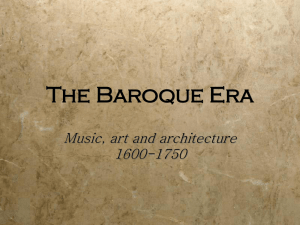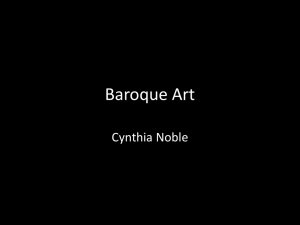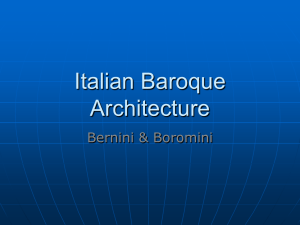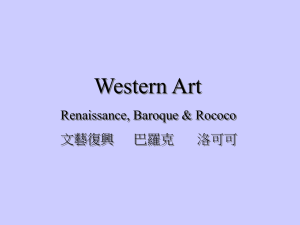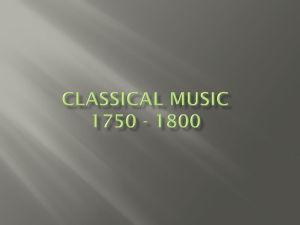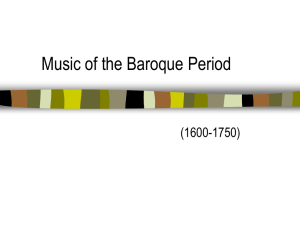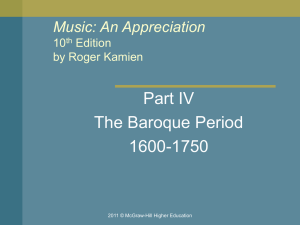Baroque architecture
advertisement
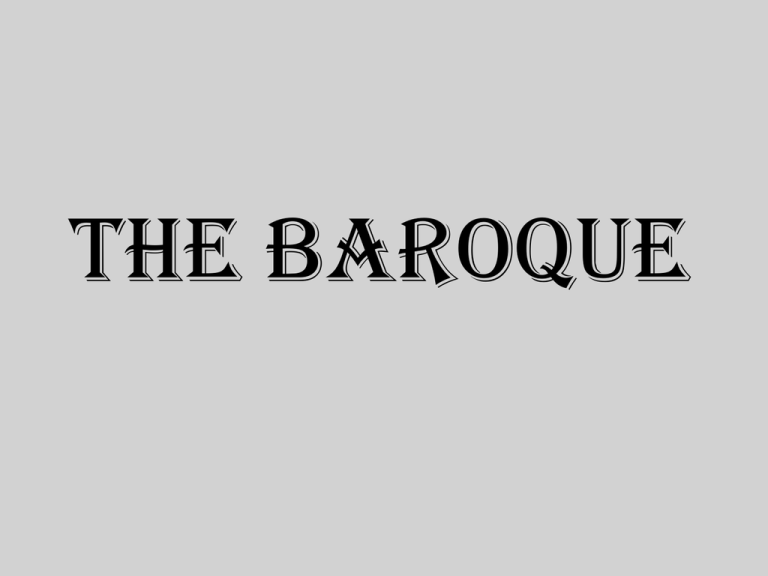
THE BAROQUE THE BAROQUE FEATURES • Baroque architecture is the building style of the Baroque era, begun in late sixteenth century in Italy, that took the Roman vocabulary of Renaissance architecture and used it in a new rhetorical and theatrical fashion, often to express the triumph of the Catholic Church and the absolutist state. It was characterized by new explorations of form, light and shadow and dramatic intensity. • Distinctive features of Baroque architecture can include: • In churches, broader naves and sometimes given oval forms • Fragmentary or deliberately incomplete architectural elements • dramatic use of light; either strong light-andshade contrasts (chiaroscuro effects) or uniform lighting by means of several windows . The Baroque in Europe SPAIN POLAND FRANCE ROMANIA TURKEY SPAIN • As Italian Baroque influences penetrated across the Pyrenees, they gradually superseded in popularity the restrained classicizing approach of Juan de Herrera, which had been in vogue since the late 16th century. As early as 1667, the façades of Granada Cathedral (by Alonso Cano) and Jaén Cathedral (by Eufrasio López de Rojas) suggest the artists' fluency in interpreting traditional motifs of Spanish cathedral architecture in the Baroque aesthetic idiom. • The west façade of the • Cathedral of Santiago • de Compostela FRANCE • The centre of Baroque secular architecture was France, where the open three-wing layout of the palace was established as the canonical solution as early as the 16th century. • Versailles's chapel Château de Les Invalides in Paris MAISON NEAR PARIS ROMANIA • Some representative Baroque structures in Transylvania are the Bánffy Palace in Cluj-NAPOCA, the Brukenthal Palace in Sibiu and the Bishopric Palace in Oradea. Besides, almost every Transylvanian town has at least a Baroque church, the most representatives of which being St. George's Cathedral of Timişoara, Saint John the Baptist Church of Târgu Mureş, the Holy Trinity Cathedral of Blaj and the Piarist Church of Cluj. Bánffy Palace in Cluj-Napoca,Transylvania POLAND • The first Baroque church in the Polish–Lithuanian Commonwealth was the Corpus Christi Church in Niasvizh, Belarus (1586–1593). It also holds a distinction of being the first domed basilica with Baroque façade in the Commonwealth and the first Baroque piece of art in Eastern Europe Church of St. Anne in Krakow Wilanów Palace in Warsaw TURKEY • Istanbul, once the capital of the Ottoman Empire, hosts many different varieties of Baroque architecture. AsTurkish architecture (which is also a combination of Islamic and Byzantine architecture) combined with Baroque, a new style called Ottoman Baroque appeared. Baroque architecture is mostly seen in mosques and palaces built in this centuries. • The Clock Tower of Dolmabahçe • Palace Ortaköy Mosque BAROQUE IN ROME • Rome has plenty of big Baroque churches, like St. Peter’s and St. John but some of the most amazing and delightful work of men like Bernini and Borromini is found in smaller, lesser known churches around the city. What makes a Baroque church a great Baroque church is a successful combination of curves, illusionistic spaces, theatricality, and movement; the Baroque is florid without being too flamboyant. Sant’Andrea al Quirinale Not surprisingly, this “pearl of the Baroque” has the touch of the 17th-century genius Gian Lorenzo Bernini. The master made use of multi-coloured marbles, stucco, and gilding to give the elliptical interior a typically Baroque richness . San Carlo alle Quattro Fontane If ever architecture could be described as tormented, this is it. Curves and countercurves. Convexity and concavity. A sense of expanding space, pushing and pulling, in a very confined interior, and you feel the tension Sant’Ivo alla Sapienza This church and its courtyard (the Biblioteca Alessandriana) are a dramatic combination of Baroque and Renaissance architecture. The genius of Borromini is especially apparent in Sant’Ivo’s spiral dome, twisting its way up from the triangular base of the church in the most exultant, fanciful way . THE END WORK MADE BY CIAMARRA PAOLA CATERINA GOLINI PETRARCONE GIAMARCO LOSI


